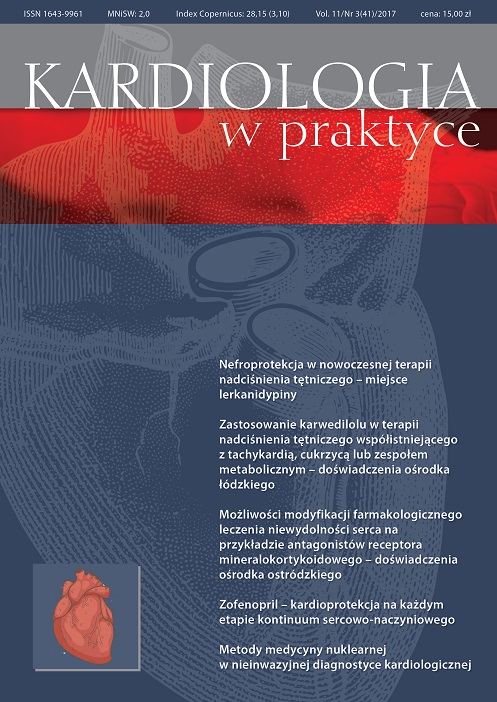Metody medycyny nuklearnej w nieinwazyjnej diagnostyce kardiologicznej Artykuł przeglądowy
##plugins.themes.bootstrap3.article.main##
Abstrakt
Medycyna nuklearna to wszelka działalność diagnostyczna i terapeutyczna z użyciem radiofarmaceutyków. Podstawowe metody to tomografia emisyjna pojedynczych fotonów (SPECT) i pozytonowa tomografia emisyjna (PET). Od ponad 40 lat medycyna nuklearna znajduje zastosowanie w kardiologii, szczególnie w diagnostyce choroby wieńcowej. W artykule omówiono najpowszechniej używane radioznaczniki, metody kardiologii nuklearnej i ich szczegółowe zastosowania.
Pobrania
##plugins.themes.bootstrap3.article.details##

Utwór dostępny jest na licencji Creative Commons Uznanie autorstwa – Użycie niekomercyjne 4.0 Międzynarodowe.
Copyright: © Medical Education sp. z o.o. This is an Open Access article distributed under the terms of the Attribution-NonCommercial 4.0 International (CC BY-NC 4.0). License (https://creativecommons.org/licenses/by-nc/4.0/), allowing third parties to copy and redistribute the material in any medium or format and to remix, transform, and build upon the material, provided the original work is properly cited and states its license.
Address reprint requests to: Medical Education, Marcin Kuźma (marcin.kuzma@mededu.pl)
Bibliografia
2. Strauss H.W., Zaret B.L., Martin N.D. et al.: Noninvasive evaluation of regional myocardial perfusion with potassium 43. Technique in patients with exercise- induced transient myocardial ischemia. Radiology 1973; 108(1): 85-90.
3. Hesse B., Lindhardt T.B., Acampa W. et al.: EANM/ESC guidelines for radionuclide imaging of cardiac function. Eur. J. Nucl. Med. Mol. Imaging 2008; 35(4): 851-885.
4. Schelbert H.R., Verba J.W., Johnson A.D. et al.: Nontraumatic determination of left ventricular ejection fraction by radionuclide angiocardiography. Circulation 1975; 51(5): 902-909.
5. Wackers F.J., Berger H.J., Johnstone D.E. et al.: Multiple gated cardiac blood pool imaging for left ventricular ejection fraction: validation of the technique and assessment of variability. Am. J. Cardiol. 1979; 43(6): 1159-1166.
6. Hegge F.N., Hamilton G.W., Larson S.M. et al.: Cardiac chamber imaging: a comparison of red blood cells labeled with Tc-99m in vitro and in vivo. J. Nucl. Med. 1978; 19(2): 129-134.
7. Maurea S., Cuocolo A., Soricelli A. et al.: Enhanced detection of viable myocardium by technetium-99m-MIBI imaging after nitrate administration in chronic coronary artery disease. J. Nucl. Med. 1995; 36(11): 1945-1952.
8. Zaret B.L., Strauss H.W., Martin N.D. et al.: Noninvasive regional myocardial perfusion with radioactive potassium. Study of patients at rest, with exercise and during angina pectoris. N. Engl. J. Med. 1973; 288(16): 809-812.
9. Nielsen A.P., Morris K.G., Murdock R. et al.: Linear relationship between the distribution of thallium-201 and blood flow in ischemic and nonischemic myocardium during exercise. Circulation 1980; 61(4): 797-801.
10. Grunwald A.M., Watson D.D., Holzgrefe H.H. Jr et al.: Myocardial thallium-201 kinetics in normal and ischemic myocardium. Circulation 1981; 64(3): 610-618.
11. Sogbein O.O., Pelletier-Galarneau M., Schindler T.H. et al.: New SPECT and PET radiopharmaceuticals for imaging cardiovascular disease. Biomed. Res. Int. 2014; 2014: 942960.
12. Pohost G.M., Zir L.M., Moore R.H. et al.: Differentiation of transiently ischemic from infarcted myocardium by serial imaging after a single dose of thallium-201. Circulation 1977; 55(2): 294-302.
13. Cerqueira M.D., Allman K.C., Ficaro E.P. et al.: Recommendations for reducing radiation exposure in myocardial perfusion imaging. J. Nucl. Cardiol. 2010; 17(4): 709-718.
14. Husain S.S.: Myocardial perfusion imaging protocols: is there an ideal protocol? J. Nucl. Med. Technol. 2007; 35(1): 3-9.
15. Gibbons R.J., Balady G.J., Beasley J.W. et al.: ACC/AHA Guidelines for Exercise Testing. A report of the American College of Cardiology/American Heart Association Task Force on Practice Guidelines (Committee on Exercise Testing). J. Am. Coll. Cardiol. 1997; 30(1): 260-311.
16. Wilson R.F., Wyche K., Christensen B.V. et al.: Effects of adenosine on human coronary arterial circulation. Circulation 1990; 82(5): 1595-1606.
17. Thomas G.S., Miyamoto M.I.: Should simultaneous exercise become the standard for adenosine myocardial perfusion imaging? Am. J. Cardiol. 2004; 94(2A): 3D-10D; discussion 10D-11D.
18. Johnston D.L., Scanlon P.D., Hodge D.O. et al.: Pulmonary function monitoring during adenosine myocardial perfusion scintigraphy in patients with chronic obstructive pulmonary disease. Mayo Clin. Proc. 1999; 74(4): 339-346.
19. DePuey E.G., Rozanski A.: Using gated technetium-99m-sestamibi SPECT to characterize fixed myocardial defects as infarct or artifact. J. Nucl. Med. 1995; 36(6): 952-955.
20. Verberne H.J., Acampa W., Anagnostopoulos C. et al.: EANM procedural guidelines for radionuclide myocardial perfusion imaging with SPECT and SPECT/CT: 2015 revision. Eur. J. Nucl. Med. Mol. Imaging 2015; 42(12): 1929-1940.
21. Machac J.: Cardiac positron emission tomography imaging. Semin. Nucl. Med. 2005; 35(1): 17-36.
22. Schlyer D.J.: PET tracers and radiochemistry. Ann. Acad. Med. Singapore 2004; 33(2): 146-154.
23. Dilsizian V., Bacharach S.L., Beanlands R.S. et al.: ASNC imaging guidelines/SNMMI procedure standard for positron emission tomography (PET) nuclear cardiology procedures. J. Nucl. Cardiol. 2016; 23(5): 1187-1226.
24. Saby L., Laas O., Habib G. et al.: Positron emission tomography/computed tomography for diagnosis of prosthetic valve endocarditis: increased valvular 18F-fluorodeoxyglucose uptake as a novel major criterion. J. Am. Coll. Cardiol. 2013; 61(23): 2374-2382.
25. Scholtens A.M., Hein J. Verberne et al.: Additional Heparin Pre-administration Improves Cardiac Glucose Metabolism suppression over low-carbohydrate diet alone in 18F-FDG PET Imaging. J. Nucl. Med. 2016; 57(4): 568-573.
26. Ozcan C., Asmar A., Gill S. et al.: The value of FDG-PET/CT in the diagnostic work-up of extra cardiac infectious manifestations in infectious endocarditis. Int. J. Cardiovasc. Imaging 2013; 29(7): 1629-1637.
27. Graziosi M., Nanni C., Lorenzini M. et al.: Role of (1)(8)F-FDG PET/CT in the diagnosis of infective endocarditis in patients with an implanted cardiac device: a prospective study. Eur. J. Nucl. Med. Mol. Imaging 2014; 41(8): 1617-1623.
28. Erba P.A., Sollini M., Conti U. et al.: Radiolabeled WBC scintigraphy in the diagnostic workup of patients with suspected device-related infections. JACC Cardiovasc. Imaging 2013; 6(10): 1075-1086.
